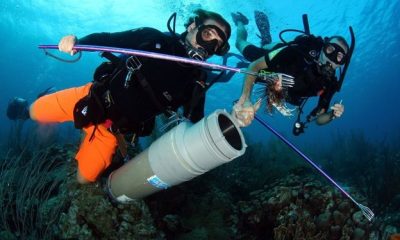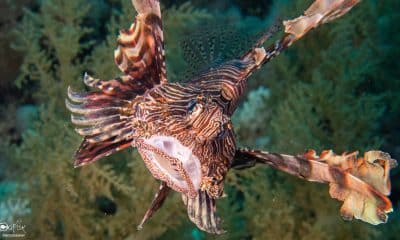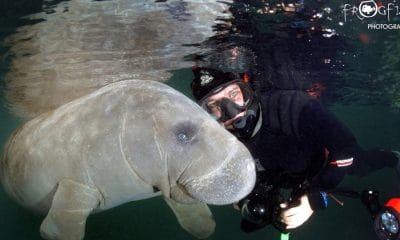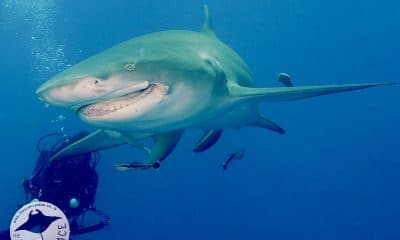News
Scuba divers ‘avert ecological disaster’ by removing invasive species from Florida waters
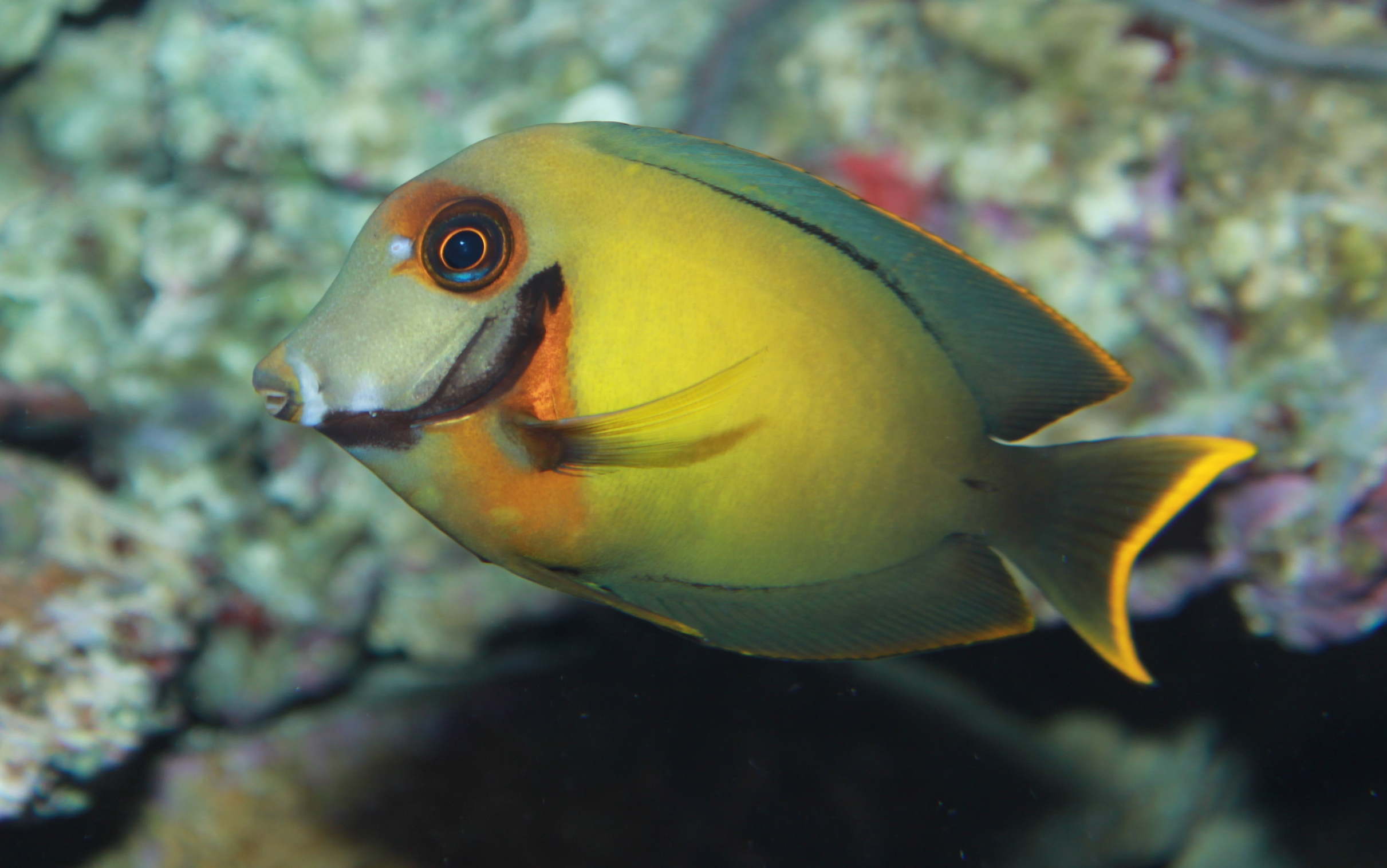
Two Florida scuba divers who were on a dive beneath Palm Beach County’s Blue Heron Bridge during the Thanksgiving holiday spotted a bright yellow fish approximately four inches long that they had never seen before.
Although some divers might have just admired it, taken a photo and kept on swimming, Deb Devers and Lureen Ferretti reported it to the Reef Environmental Education Foundation (REEF) — a Key Largo-based non-profit organization that serves as a regional clearinghouse for control of exotic marine fish species.
“They weren’t sure what it was, but they knew it was something that doesn’t belong here,” said Las Akins, director of special projects for REEF.
Akins said their instincts were correct: the fish was a mimic lemon peel surgeonfish, also known as a chocolate surgeonfish, native to the Indo-Pacific and the first of its kind documented in Florida waters. Devers kept track of the fish, and last month, she and Akins captured it alive using hand nets. It was sent to the Ripley’s Aquarium of Canada to be displayed as an educational tool on the hazards of invasive species.
Akins said the removal might have averted an ecological disaster similar to the spread of lionfish — another Indo-Pacific invader now well-established in the Western Atlantic, Gulf of Mexico and Caribbean. Lionfish — first sighted off Dania Beach in 1985 and believed to be an abandoned aquarium pet — have been blamed for wiping some local reef systems clean of native tropical fish.
“We don’t know what the effects would have been if the fish had become established and began reproducing,” said Akins. “But if we wait to find out, then it’s too late.”
According to REEF, taking out the surgeonfish was the third successful preemptive strike against a non-native marine fish species in Florida coastal waters.
In 1999 and 2002, REEF staff and volunteers captured four large Indo-Pacific batfish from Molasses Reef in Key Largo. In 2009, they removed a whitetail dascyllus damselfish from the east side of the Blue Heron Bridge. In 2012, Miami divers Greg Caterino and Wayne Grammes speared an exotic humpback grouper on a reef off Biscayne National Park and turned the carcass over to REEF. Akins said none of those three species are known to have reappeared in Florida waters since their removals.
“Some people might say, ‘Oh big deal, we took this little fish out of the water,’” Akins said. “But that’s the way the lionfish got started. If only we could have taken the first few lionfish out of the water in the first place. We’re relying on divers, snorkelers and fishermen to be our eyes and ears on the water. It’s a perfect example of how early detection and rapid removal can be successful in stemming an invasion.”
Releasing non-native fish into Florida waters not only is harmful, but also illegal. The Florida Fish and Wildlife Conservation Commission encourages pet owners who need to find new homes for their fish or other exotic animals to call the FWC’s Exotic Species Hotline at 1-888-IveGot1.
Anyone who spots a strange-looking fish that they suspect is invasive is advised to take a photo and report the sighting at reef.org.
Gear News
Scubapro Free Octopus Promotion 2024

Free Octopus with every purchase of a SCUBAPRO regulator system
Just in time for the spring season, divers can save money with the FREE OCTOPUS SPRING PROMOTION! Until July 31st SCUBAPRO offers an Octopus for free
with every purchase of a regulator system!
Get a free S270 OCTOPUS with purchase of these combinations:
MK25 EVO or MK19 EVO with A700
MK25 EVO or MK19 EVO with S620Ti
MK25 EVO or MK19 EVO with D420
MK25 EVO Din mit S620Ti-X
Get a free R105 OCTOPUS with purchase of the following combinations:
MK25 EVO or MK19 EVO with G260
MK25 EVO or MK17 EVO with S600
SCUBAPRO offers a 30-year first owner warranty on all regulators, with a revision period of two years or 100 dives. All SCUBAPRO regulators are of course certified according to the new European test standard EN250-2014.
Available at participating SCUBAPRO dealers. Promotion may not be available in all regions. Find an authorized SCUBAPRO Dealer at scubapro.com.
More information available on www.scubapro.com.
Blogs
Northern Red Sea Reefs and Wrecks Trip Report, Part 3: The Mighty Thistlegorm

Jake Davies boards Ghazala Explorer for an unforgettable Red Sea diving experience…
Overnight, the wind picked up, making the planned morning dive a bit bumpy on the Zodiacs to the drop point on Thomas Reef. There, we would dive along the reef before descending through the canyon and then passing under the arch before ascending the wall with a gentle drift. The site provided great encounters with more pelagic species, including shoals of large barracuda, tuna, and bigeye trevally.
Once back on the boat, it was time to get everything tied down again as we would head back south. This time, with the wind behind us, heading to Ras Mohammed to dive Jackfish Alley for another great gentle drift wall dive before then heading up the coast towards the Gulf of Suez to moor up at the wreck of the Thistlegorm. This being the highlight wreck dive of the trip and for many onboard, including myself, it was the first time diving this iconic wreck. I had heard so much about the wreck from friends, and globally, this is a must on any diver’s list. Fortunately for us, there was only one other boat at the site, which was a rarity. A great briefing was delivered by Ahmed, who provided a detailed background about the wreck’s history along with all the required safety information as the currents and visibility at the site can be variable.

Kitting up, there was a lot of excitement on deck before entering the water and heading down the shoreline. Descending to the wreck, there was a light northerly current which reduced the visibility, making it feel more like the conditions that can be found off the Welsh coast. At 10m from the bottom, the outline of the wreck appeared as we reached the area of the wreck which had been bombed, as our mooring line was attached to part of the propeller shaft. Arriving on deck, instantly everywhere you looked there were many of the supplies which the ship was carrying, including Bren Carrier tanks and projectiles that instantly stood out.

We headed around the exterior, taking a look at the large propeller and guns mounted on deck before entering the wreck on the port side to take a look in the holds. It was incredible to see all the trucks, Norton 16H, and BSA motorcycles still perfectly stacked within, providing a real snapshot in time.

Overall, we had four dives on the Thistlegorm, where for all of the dives we were the only group in the water, and at times, there were just three of us on the whole wreck, which made it even more special, especially knowing that most days the wreck has hundreds of divers. Along with the history of the wreck, there was plenty of marine life on the wreck and around, from big green turtles to batfish, along with shoals of mackerel being hunted by trevally. Some unforgettable dives.

The final leg of the trip saw us cross back over the Suez Canal to the Gobal Islands where we planned to stay the night and do three dives at the Dolphin House for the potential of sharing the dive with dolphins. The site, which included a channel that was teeming with reef fish, especially large numbers of goatfish that swam in large shoals along the edge of the reef. These were nice relaxing dives to end the week. Unfortunately, the dolphins didn’t show up, which was okay as like all marine life they are difficult to predict and you can’t guarantee what’s going to be seen. With the last dive complete, we headed back to port for the final night where it was time to clean all the kit and pack before the departure flight the next day.

The whole week from start to finish on Ghazala Explorer was amazing; the boat had all the facilities you need for a comfortable week aboard. The crew were always there to help throughout the day and the chefs providing top quality food which was required after every dive. The itinerary providing some of the best diving with a nice mixture of wreck and reef dives. I would recommend the trip to anyone, whether it’s your first Red Sea liveaboard in the Red Sea or you’re revisiting. Hopefully, it’s not too long before I head back to explore more of the Red Sea onboard Ghazala Explorer.

To find out more about the Northern Red Sea reef and wrecks itineraries aboard Ghazala Explorer, or to book, contact Scuba Travel now:
Email: dive@scubatravel.com
Tel: +44 (0)1483 411590
Photos: Jake Davies / Avalon.Red
-

 News3 months ago
News3 months agoHone your underwater photography skills with Alphamarine Photography at Red Sea Diving Safari in March
-

 News3 months ago
News3 months agoCapturing Critters in Lembeh Underwater Photography Workshop 2024: Event Roundup
-

 Marine Life & Conservation Blogs2 months ago
Marine Life & Conservation Blogs2 months agoCreature Feature: Swell Sharks
-

 Blogs2 months ago
Blogs2 months agoMurex Resorts: Passport to Paradise!
-

 Blogs2 months ago
Blogs2 months agoDiver Discovering Whale Skeletons Beneath Ice Judged World’s Best Underwater Photograph
-

 Gear Reviews3 months ago
Gear Reviews3 months agoGear Review: Oceanic+ Dive Housing for iPhone
-

 Marine Life & Conservation2 months ago
Marine Life & Conservation2 months agoSave the Manatee Club launches brand new webcams at Silver Springs State Park, Florida
-

 Gear Reviews2 weeks ago
Gear Reviews2 weeks agoGEAR REVIEW – Revolutionising Diving Comfort: The Sharkskin T2 Chillproof Suit





